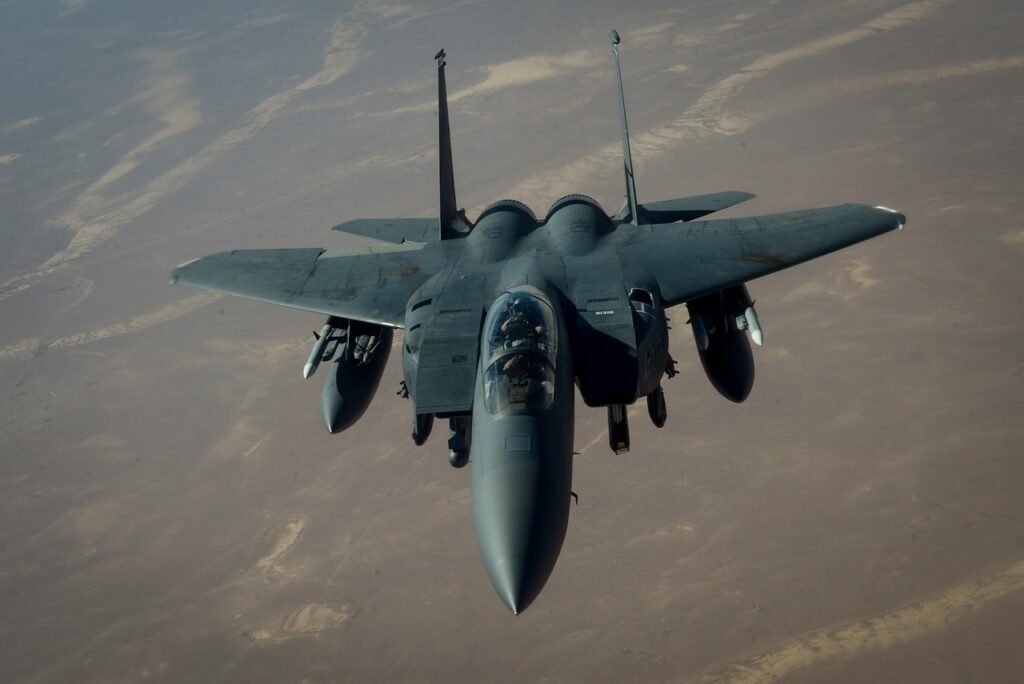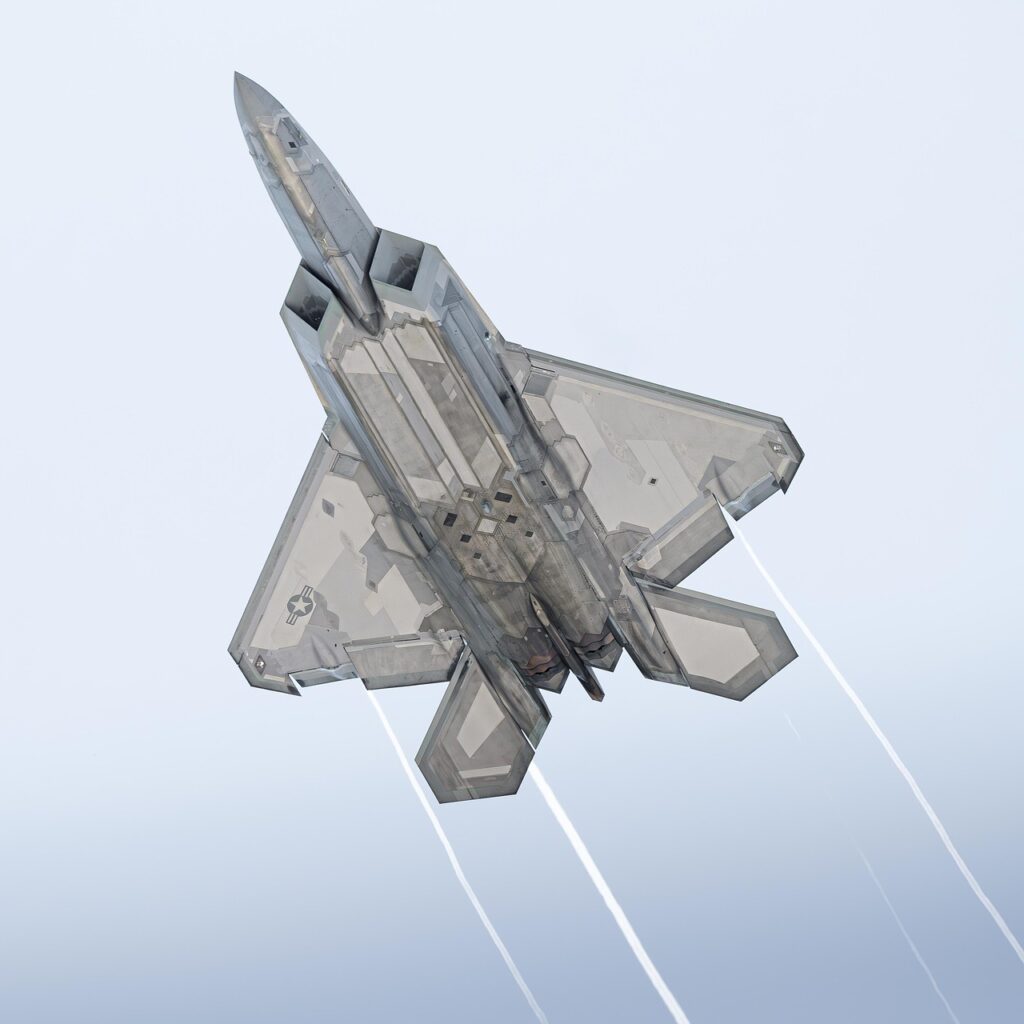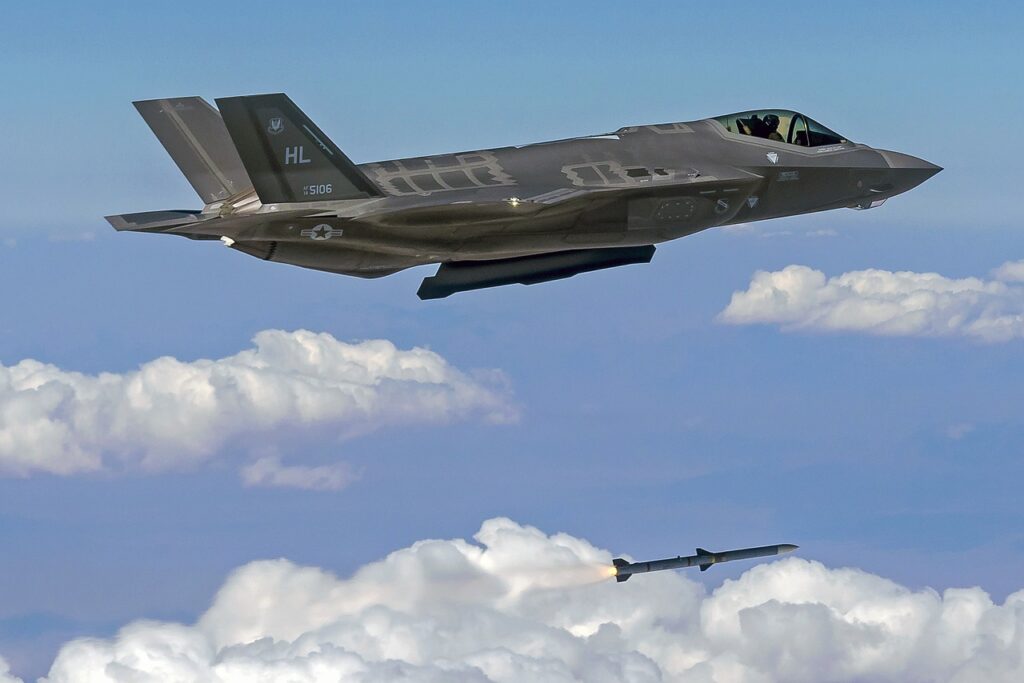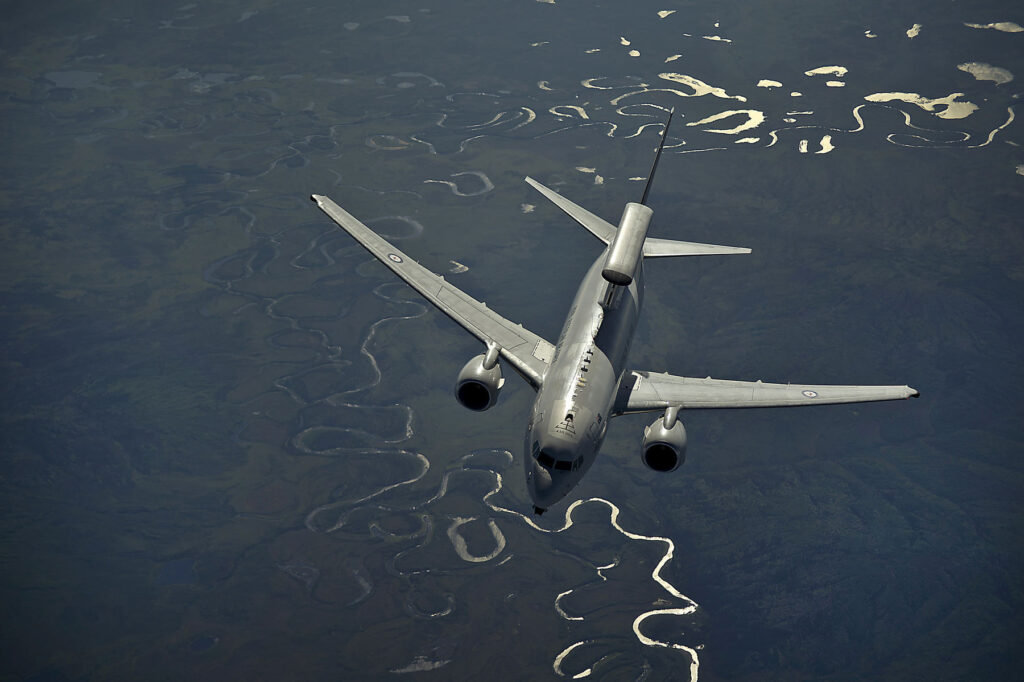Hoag Levins’ 1983 book, Arab Reach, examined the technologies involved in the momentous 1981 U.S. Senate decision to provide Airborne Warning and Control Systems (AWACS) to Saudi Arabia, a move that for the first time favored Arab interests over Israel.
Levins wrote: “Up until 1978 the Israel and Arab lobbies in Washington existed at either extreme of the scale: the Israel lobby being noted for its invincibility and clout, the Arab lobby for its invisibility and impotence.
“Since 1947 this solid Israeli grip on America’s internal political processes has been one of the three most important pillars upon which Israel’s existence has depended. The other two pillars have been its exclusive access to the high-technology weapons systems of the American arsenal and its own secret weapons systems, which are detailed later in this work.
“In 1978, suddenly, two of those Israeli pillars – exclusive access to America’s state-of-the-art weapons systems and monopolistic hold on the Washington political machinery which directly controlled U.S. foreign policy in the Middle East – were challenged by an emerging Arab lobby.
“In its first public contest against the most powerful lobbying group in Washington, the Arabs worked in tandem with newly organized Arab-American political organizations and cooperative American corporations which had multimillion-dollar stakes in projects throughout the Muslim Middle East.
“That 1978 battle in the Senate is really the story of an airplane, an amazing airplane named for a predatory bird, but physically resembling nothing so much as a sheet-metal killer wasp.”
Levins painted a vivid picture of the F-15 Eagle and AWACS technology, describing capabilities that seemed almost otherworldly at the time. The F-15, a “$30 million Eagle,” was portrayed as the apex of attack jet design, unmatched in speed, accuracy, and range, capable of dominating any aerial battle. The AWACS, likened to a “gigantic eye in the sky,” could track hundreds of targets and orchestrate aerial engagements with an “octopus-like apparatus” of F-15s. Levins’ engaging prose captured the imagination, suggesting a future of aerial warfare dominated by sophisticated electronic systems.
In 1983, Levins wrote: “The $30 million F-15 Eagle does what every other military plane in the world does – only faster, more accurately and from farther away. Built by McDonnell Douglas for the United States Air Force, the craft was designed as the world’s most advanced attack jet. No other nation – not even the Soviet Union – has produced a plane which can match this one’s performance. It is a record setter for altitude and speed levels; its radar is the most sophisticated; its ability to execute intricate maneuvers, including straight-up climbs, unprecedented.

“In an all-out battle between half a dozen of any other kinds of jets and one Eagle, the Eagle is the sure winner. Grouped in squadrons, the planes’ unusual capabilities allow for the seizure of huge swaths of sky. If any popular movie were cited to suggest to the layman the sort of battle techniques the F-15 development represents for aerial warfare, it would not be Fighter Aces but Star Wars.
“In the beginning of aerial warfare, planes battled each other one-on-one with guns crudely bolted to their fuselages. Dueling pilots came close enough to see each other’s faces as their propeller crafts jabbed this way and that, seeking advantage. This method of fighting changed as rapidly as the shape of the airplanes themselves. Planes became faster and guns became heavier and more powerful, able to hit other planes from increasing distances. This distance – the ‘lethal reaction area’ commanded by any plane – is the single most important factor in the outcome of most aerial conflicts. Think of it as something similar to the advantage a long-armed boxer enjoys over a shorter-armed opponent-a plane which can begin ripping holes in another plane before that other plane can effectively rip back usually wins.
“By the late 1960s planes no longer relied on either human eyesight or bullets in such battles. Radar and computer-assisted sensing systems scanned not only across clouds but around the curve of the earth beyond. Weapons were no longer guns but small jet planes packed with high explosives-missiles-launched from the belly racks of a larger manned plane and guided electronically toward the enemy plane, which could be no more than an infinitesimal speck on the horizon.

“Total electro-mechanical war-battles fought between pieces of self-guiding, self-adjusting, self-actuating machinery rather than individual human beings – became a reality with the advent and widespread use of the Phantom F-4 jet. That plane had been fitted with the most extensive systems of computer-assisted flight-control and weapons-guidance systems ever installed in an aircraft. The Phantom era of aerial supremacy ended in 1976 with the arrival of the F-15.
“The F-15 is a quantum leap over the Phantom. It is not a jet fighter into which computer equipment has been installed but, rather, a space-age computer system of extraordinary complexity to which wings, wheels and two incredibly powerful jet engines have been attached. The Phantom and similar aircraft were vehicles flown and operated by men assisted by computers. The F-15 is a vehicle flown and operated by computers assisted, when necessary, by men.
“Its cockpit lacks the traditional bristle of levers, dials, toggles and handles and has, instead, a few digital panels. It is the first fully digital-controlled warplane. In operation, its central IBM brain takes into account the information provided by its various sensing, analyzing and data-storage systems and provides commands for the pilot to follow. In some cases these commands are translated into simple dot patterns to be followed on a screen-so as not to risk confusing the human at a time when split-second reactions are required to avoid destruction or to destroy another piece of machinery moving at supersonic speeds.
“One of the most important features of the F-15 is the enormous ‘lethal reaction area’ commanded by its computer sensors and weapons systems across any given stretch of territory. For a better visual feel of this phenomenon, imagine that a dim aura of colored light emanates from the plane, illuminating the craft’s absolute killing range as it passes over your home in the night sky.
“That illumination would reach out in all directions, ultimately forming a ball of light more than two hundred miles in diameter. Nothing moves inside that space without the F-15’s central computer detecting it, analyzing it with radar beacons as ‘friend or foe’ and, if required, locking it on target and destroying it with a guided missile, all of this occurring in a period of time shorter than that required to read this paragraph.
“And the F-15, for all its awesome powers, is only an individual smaller part of a larger weapons system and battle technique unfamiliar to most Americans, who still think of air war in terms of the highly popularized World War II air battles.
“During the Vietnam War, the United States military began linking individual warplanes into a computer system which then used the planes as moving ‘parts’ of a larger flock pattern of aircraft being controlled and coordinated from a single command post. By the 1970s this technology became the basis for the development of AWACS Airborne Warning and Control Systems.
“This is the basic principle: The AWACS’s electronic systems provide a picture of the entire region, like a gigantic eye in the sky able to see everything moving everywhere in any given battle region. The AWACS whose screens and scans and computer consoles look something like the inside of a NASA control center-can track six hundred different targets in the air, on land or across water simultaneously. It can identify and target for destruction 240 targets simultaneously.

“The AWACS command crews then use the F-15s to respond to the entire battleground below, moving the individual planes much like blips across the screen of a large video game to intercept and destroy approaching planes here, bomb a tank corps there or missile a patrol cruiser farther on down the field.
“This development-aerial electronic systems warfare-was perfected and deployed as the new standard practice of the United States Air Force in the late 1970s. It represents a complete revolution of battle tactics and defense systems. Think of it as a sort of electro-assembly of dozens of airplanes an octopus-like apparatus able to descend and seize the entire sky along a thousand-mile battlefront. At the end of each of its invisible electronic tentacles is an F-15 fighter jet functioning as a direct extension of the mother ship’s computer. This aerial constellation of linked airplanes is capable of performing mind-boggling feats of warfare.
“At the same time, such individual constellations are only parts of a larger system of space-age battle machinery connected by the in- visible control matrix emanating from AWACS mother ships. This ‘electronic womb’ or ‘electronic atmosphere’ is spun across an entire war zone, monitoring and directing armies, artillery brigades and missile-launching armored corps on the ground; flotillas of missile-launching ships at sea; and constellations of missile-launching jets in the sky. This electro-apparatus functions as a single, enormous machine moving whichever of its parts are needed for defense or attack.”
That was 1983. This report aims to revisit that vision, examining how the technologies described by Levins have evolved into the even more advanced and multifaceted aerial warfare capabilities that exist in 2025. We will explore the transformation of fighter jets, the advent of stealth technology, the revolution in radar and sensors, the increased lethality and range of missiles, the enhanced capabilities of airborne early warning and control platforms, the integration of network-centric warfare principles, and the burgeoning role of artificial intelligence in shaping the skies.
The F-15 Then and Now: A Legacy of Air Superiority
Levins’ depiction of the F-15 highlighted its superiority in the early 1980s, emphasizing its record-setting performance in altitude and speed, its sophisticated radar, and its unprecedented maneuverability. The claim was that in a battle against multiple other jets, the F-15 would be the “sure winner,” its capabilities almost resembling the science fiction of “Star Wars.” While the F-15 remains a capable aircraft even in 2025, the landscape of aerial warfare has shifted dramatically with the emergence of fifth-generation fighters like the F-22 Raptor and the F-35 Lightning II.

The F-22 Raptor, a product of the United States Air Force’s Advanced Tactical Fighter program, represents a significant leap beyond the capabilities of the F-15.1 Designed primarily as an air superiority fighter, the F-22 also incorporates ground attack, electronic warfare, and signals intelligence functionalities.1 Its combination of stealth, supercruise, exceptional maneuverability, and integrated avionics marks an “exponential leap in warfighting capabilities”.2 The F-22’s advanced sensor suite allows pilots to track, identify, engage, and eliminate air-to-air threats before the Raptor itself is detected, offering a crucial “first-kill opportunity”.2 Its sophisticated radar and fully digital-controlled cockpit further enhance its dominance.2 Notably, the F-22 can cruise at supersonic speeds exceeding Mach 1.5 without using fuel-consuming afterburners, a characteristic known as supercruise.2 This capability provides a significant advantage in both speed and range compared to the F-15. While configured for air-to-ground missions, the F-22 can carry substantial ordnance internally, maintaining its stealth profile.2 Ongoing modernization efforts in 2025 include the integration of advanced infrared threat-detection sensors (IRDS) to further improve the aircraft’s survivability and lethality.4 These sensors offer 360-degree passive infrared surveillance and long-range targeting, enabling the F-22 to detect and engage adversaries often before their own detection systems are alerted.5 Due to its advanced capabilities and network connectivity, the F-22 can also function as a highly capable “quarterback” for larger aerial force packages.6

The F-35 Lightning II is another fifth-generation stealth strike fighter that has surpassed the F-15’s original capabilities.7 Designed as a multirole combat aircraft, the F-35 excels in air superiority and strike missions, while also possessing electronic warfare and intelligence, surveillance, and reconnaissance (ISR) capabilities.7 Its advanced sensor suite includes an Active Electronically Scanned Array (AESA) radar, a Distributed Aperture System (DAS), and an Electro-Optical Targeting System (EOTS).8 A key feature of the F-35 is its sensor fusion capability, which automatically analyzes and merges data from its various onboard sensors, providing pilots with an integrated and intuitive understanding of their surroundings, significantly enhancing survivability and effectiveness.8 This reduces the cognitive burden on pilots, allowing them to operate as more effective tacticians.10 Modernization efforts continue in 2025 with the Block 4 upgrades, which include new sensors, enhanced weapon integration, and electronic warfare improvements.11 There is even discussion of a “supercharged” F-35 incorporating technologies from the next-generation F-47, potentially achieving a significant portion of its capability at a reduced cost.12 This could involve integrating advanced passive infrared sensors, further enhancing stealth, incorporating longer-range weapons, and enabling stealthy communications.13 The F-35 is considered a crucial element in modern warfare, acting as the “Most Advanced Node in the 21st Century Warfare” due to its unmatched data-sharing capabilities and its central role in enabling Joint All Domain Operations.8
While the fifth-generation fighters represent a clear evolution, the F-15 itself has not remained static. The F-15EX Eagle II is the latest iteration of this venerable platform, bridging the gap between fourth and fifth-generation aircraft.16 It boasts a modernized avionics suite, an all-new electronic warfare system known as the Eagle Passive/Active Warning Survivability System (EPAWSS) with the AN/ALQ-250, and the powerful AN/APG-82(V)1 AESA radar.18 One of the most significant advancements in the F-15EX is its greatly expanded weapons carriage capacity, allowing it to carry over 29,000 pounds of ordnance, earning it the moniker of a “weapons truck”.16 It can carry up to 12 air-to-air missiles and potentially more with expanded racks, along with large standoff weapons like the Joint Air-to-Surface Standoff Missile (JASSM) and potentially even hypersonic missiles.18 The F-15EX is designed to act as a forward-edge battle manager, capable of quarterbacking air superiority operations by serving as a networked communication node and providing a pathway to integrate with future collaborative combat aircraft (CCAs).18 It is also intended to accompany fifth-generation aircraft, leveraging their advanced sensors.17 Furthermore, the F-15EX incorporates passive threat detection capabilities with the Lockheed Martin Legion Pod, equipped with the AN/ASG-34(V)1 IRST21 sensor.19
The progression from the F-15 to these modern fighters illustrates a fundamental shift in aerial warfare. While speed and maneuverability remain important, the emphasis has expanded to include stealth, sophisticated sensor integration, and seamless network connectivity. The F-15EX represents a modern evolution of a proven design, leveraging contemporary technologies to complement the unique strengths of the fifth-generation platforms.
The Art of Invisibility: Stealth Technology Takes Center Stage
A key difference between the F-15 of 1983 and the advanced fighters of 2025 is the incorporation of stealth technology. Stealth, or low observable technology, aims to evade detection by enemy sensors, primarily radar, but also infrared, visual, and acoustic means.22 This is achieved through a combination of airframe shaping designed to deflect radar waves away from the emitter, the use of radar-absorbent materials (RAM) to absorb radar energy, and measures to reduce heat and noise signatures.1 The F-15, in its original design, did not incorporate significant stealth features.1
In contrast, the F-22 Raptor was designed from the outset with stealth as a primary consideration.1 Its airframe is shaped with aligned edges and continuous curvature to minimize its radar cross-section (RCS). It carries its weapons internally in three weapons bays to avoid the increased radar signature of external stores. Serpentine inlets prevent direct radar reflections from the engine fan faces, and RAM is used on its surfaces to absorb incoming radar waves.1 The F-22 even has an onboard system to warn the pilot if its radar signature is degraded.1 Its design also focused on reducing radio frequency emissions, infrared signature through rectangular thrust-vectoring nozzles that flatten and cool the exhaust plume, acoustic signature, and visual visibility.1 The F-22’s RCS from certain angles is reportedly as low as that of a “steel marble”.1
The F-35 Lightning II also heavily emphasizes stealth in its design.7 Its radar cross-section is minimized through careful shaping, the use of RAM, aligned edges, continuous surface curvature, and serrated skin panels. It employs diverterless supersonic inlets (DSI) to manage the boundary layer and further reduce its radar signature.7 The RCS of the F-35 has been characterized as lower than a metal golf ball at certain frequencies and angles, and in some conditions, it can even be comparable to the F-22 in stealth performance, although its stealth is primarily optimized for high-frequency X-band wavelengths.7
While stealth technology provides a significant advantage, it is not absolute. Low-frequency radars, for example, can sometimes detect stealth aircraft, albeit with less precision.23 Infrared sensors can also detect the heat signatures of stealth aircraft.27 Consequently, there is an ongoing development of countermeasures to both enhance stealth and to detect stealthy opponents.23 The future of stealth technology in “sixth-generation” fighters may involve further advancements, such as the reduction or complete removal of vertical tails and the use of novel radar-absorbing materials.26
Seeing the Unseen: The Evolution of Radar and Sensors
The F-15 in 1983 likely utilized a mechanically scanned array radar, which was the cutting-edge technology of the time. These radars physically moved their antenna to scan the airspace. However, modern fighter jets have transitioned to Active Electronically Scanned Array (AESA) radars, which offer significant improvements.8 The F-22 is equipped with the AN/APG-77, the F-35 with the AN/APG-81, and the F-15EX with the AN/APG-82(V)1 AESA radar.8 AESA radars do not rely on physical movement; instead, they use an array of small transmit/receive modules that can be electronically steered, allowing for faster scan rates, the ability to track multiple targets simultaneously, greater detection ranges, and enhanced resistance to electronic jamming.16
Another crucial sensor technology that has emerged since 1983 is the Infrared Search and Track (IRST) system. These passive sensors detect and track targets based on their infrared (heat) signatures, without emitting any signals that could alert the enemy.5 Modernized F-22s are being equipped with advanced IRST systems 4, and the F-35 integrates an IRST capability into its Electro-Optical Targeting System (EOTS).12 IRST systems are particularly valuable for detecting stealth aircraft, which are optimized against radar, and for operating in environments where radar jamming is prevalent.5
The integration of these advanced sensors has led to a significantly expanded “lethal reaction area” for modern fighter jets. AESA radars can detect targets at much greater distances than their predecessors, and IRST systems provide an additional layer of detection, especially against low-observable threats.5 The F-35 further enhances situational awareness with its Distributed Aperture System (DAS), which uses six infrared cameras mounted around the aircraft to provide the pilot with a real-time, 360-degree view of the battlespace.8
Connected Skies: Network-Centric Warfare and Sensor Fusion
The concept of network-centric warfare (NCW) represents a paradigm shift in military operations since 1983. NCW emphasizes the importance of linking sensors, decision-makers, and shooters through information networks to achieve shared awareness and enhanced combat power.29 This contrasts sharply with the more isolated operations of individual aircraft in the early 1980s. Modern fighter jets like the F-22 33 and F-35 8 are designed as integral nodes in this digital battlefield, capable of sharing data in real-time with other aircraft, ground stations, and naval assets.28
A critical component of NCW is sensor fusion. In modern fighters, data from multiple onboard sensors, including radar, IRST, DAS, and electronic warfare systems, is automatically analyzed and merged to create a single, integrated, and intuitive view of the battlespace for the pilot.2 This significantly reduces pilot workload compared to the F-15 era, where pilots had to interpret information from numerous independent displays. Data links like Link 16 play a crucial role in enabling the real-time exchange of tactical information between different platforms.37 Even upgraded legacy platforms like the F-15EX are being integrated into this network-centric environment, acting as forward-edge battle managers and communication hubs.18 The ability of the F-35 to “take in and share so much data across the force” exemplifies how this interconnectedness enhances the lethality and survivability of all participating platforms.9
The Reach of Modern Missiles: From Sidewinders to Beyond Visual Range
In 1983, air-to-air missile technology primarily consisted of short-range, infrared-guided missiles like the AIM-9 Sidewinder and medium-range, semi-active radar-guided missiles like the AIM-7 Sparrow.39 Since then, significant advancements have been made in both types. Infrared-guided missiles now possess all-aspect attack capability, meaning they can lock onto targets from any angle, not just from behind where the engine exhaust is strongest.39 Later versions of the Sidewinder, such as the AIM-9X, feature improved seeker technology for better discrimination against countermeasures and even offer off-boresight targeting capabilities, allowing the pilot to engage targets outside the aircraft’s immediate forward view.40 The AIM-9X also incorporates a datalink for receiving updated target information mid-flight.40

The AIM-120 AMRAAM (Advanced Medium Range Air-to-Air Missile) has replaced the AIM-7 Sparrow as the standard medium-range missile. The AMRAAM utilizes active radar homing, meaning it has its own radar seeker to track the target after initial guidance, enabling beyond-visual-range (BVR) engagements.39 Successive versions of the AMRAAM have seen increasing range and sophistication, culminating in variants like the AIM-120D, which boasts a range of over 100 miles, GPS-assisted guidance, and improved resistance to electronic jamming.40 Looking further ahead, missiles like the AIM-260 Joint Advanced Tactical Missile (JATM) are under development with the specific aim of countering stealth targets and restoring the “first look, first kill” advantage.13 The F-15EX will also be capable of carrying air-launched hypersonic missiles, representing a significant leap in speed and standoff range for air-to-air engagements.18
The evolution of air-to-air missile technology reflects a clear trend towards longer engagement ranges, greater accuracy, improved resistance to countermeasures, and the ability to attack targets from any direction. This increased reach has fundamentally altered aerial combat tactics, reducing the likelihood of close-range dogfights while emphasizing the importance of detecting and engaging threats at extended distances.
The Eyes in the Sky: AWACS and its Modern Successors
The AWACS, as described in 1983, provided a revolutionary capability by offering a wide-area surveillance picture and the ability to direct fighter aircraft. The platform likely referred to was the Boeing E-3 Sentry, which entered service in the 1970s.43 While the E-3 remains in service in 2025, its age and maintenance demands have led to the selection of a successor: the Boeing E-7 Wedgetail.38
The E-7 Wedgetail represents a significant upgrade over the E-3 Sentry. Its most notable feature is the advanced Northrop Grumman Multi-Role Electronically Scanned Array (MESA) radar, which provides continuous 360-degree coverage without the need for a rotating antenna like the E-3.38 The MESA radar offers superior detection and tracking capabilities, including an enhanced ability to detect stealth targets.38 The E-7 also boasts improved capabilities in target tracking, data processing, and communication with other military assets, enabling more seamless coordination across complex operations.45 It offers greater range and endurance than the E-3 45, and its open systems architecture allows for easier integration of future technological advancements.46 Beyond the E-7, other modern AEW&C platforms like the Saab GlobalEye 54 and various Chinese designs 57 demonstrate the continued global importance and advancement of this technology. There is even anticipation of future AEW&C systems incorporating unmanned aircraft and space-based assets.38

The evolution of AEW&C platforms underscores a trend towards more reliable and higher-performing electronically scanned array radars, enhanced sensor integration, and improved network connectivity. These modern “eyes in the sky” serve as critical command and control nodes, providing essential situational awareness and enabling the effective coordination of forces across multiple domains. They are also increasingly integrated into broader air defense networks, working in concert with ground-based surface-to-air missile systems.46
The Rise of the Machines: Artificial Intelligence in Aerial Combat
A transformative element largely absent from the 1983 vision is the integration of artificial intelligence (AI) and machine learning into modern aerial warfare systems.61 In 2025, AI is being implemented in various aspects of aerial combat. It plays a crucial role in analyzing the vast amounts of data generated by advanced sensors, helping pilots to identify threats and make informed decisions in complex and rapidly evolving situations.62 The U.S. Air Force’s VENOM program is actively developing AI “agents” capable of autonomously flying fighter jets, using modified F-16s as testbeds.66 These AI agents have even demonstrated success in simulated dogfights against human pilots.63
The concept of manned-unmanned teaming (MUM-T) is also gaining traction, where AI-powered drones, often referred to as Collaborative Combat Aircraft (CCA), will operate alongside manned fighters. This has the potential to significantly increase firepower and reduce the risks to human pilots by assigning drones to more dangerous tasks.12 AI is also finding its way into AEW&C platforms, where it can be used for real-time data analysis, pattern recognition, and potentially even autonomous decision-making in certain scenarios.55 While the integration of AI offers numerous potential benefits, it also raises ethical considerations and challenges, particularly concerning the level of autonomy granted to weapon systems.63
A New Era of Aerial Warfare: Comparing Past and Present
The aerial warfare landscape of 2025 is vastly different from the one depicted in 1983. The key technological advancements of the past four decades – stealth technology, AESA radars, IRST systems, advanced air-to-air missiles, network-centric warfare, and the integration of AI – have collectively transformed how air power is projected and employed. Aerial combat has shifted from a potential focus on close-range engagements to longer-range, more information-driven operations. The complexity and interconnectedness of modern aerial warfare systems are far greater than what was conceivable in the early 1980s. The “electronic womb” or “electronic atmosphere” envisioned by Levins has indeed become a reality, but in a far more intricate and capable form. The pursuit of greater range, accuracy, survivability, and information dominance continues to drive innovation, promising further evolution in the years to come.
Key Tables
- Comparison of Fighter Jet Capabilities (1983 vs. 2025)
| Feature | F-15 Eagle (1983) | F-22 Raptor (2025) | F-35 Lightning II (2025) | F-15EX Eagle II (2025) |
| Speed | Mach 2.5+ | Supercruise > Mach 1.5, Max Mach 2.25 | Mach 1.6 | Mach 2.5 |
| Maneuverability | High | Exceptional (thrust vectoring) | High | High |
| Radar Type | Mechanically Scanned Array | AESA (AN/APG-77) | AESA (AN/APG-81) | AESA (AN/APG-82(V)1) |
| Stealth | No | Yes (low observability) | Yes (low observability) | Limited |
| Key Sensors | Radar | Radar, IRST (in modernization), ESM | Radar, IRST (EOTS), DAS, ESM | Radar, IRST (Legion Pod), ESM (EPAWSS) |
| Weapons Carriage | External | Internal & External | Internal & External | Extensive External & Conformal (over 29,000 lbs) |
| Network Connectivity | Limited | Advanced (Joint All-Domain Operations) | Advanced (Joint All-Domain Operations) | Advanced (Forward-Edge Battle Management) |
- Evolution of Air-to-Air Missiles
| Missile Name | Guidance Type | Range (Approximate) | Key Advancements |
| AIM-9 Sidewinder (1983) | Infrared | Short | Rear-aspect lock-on |
| AIM-9 Sidewinder (Modern) | Infrared | Short to Medium | All-aspect lock-on, improved countermeasures, off-boresight targeting (AIM-9X) |
| AIM-7 Sparrow (1983) | Semi-Active Radar | Medium | |
| AIM-120 AMRAAM (Various) | Active Radar | Medium to Long | Beyond-visual-range capability, increasing range and sophistication |
| AIM-260 JATM (Development) | Active Radar | Very Long | Designed to counter stealth targets |
- Comparison of AEW&C Platforms
| Platform | Radar Type | Target Tracking Capacity | Key Improvements |
| E-3 Sentry (1983) | Mechanically Scanned | Hundreds | First AEW to use pulse-Doppler radar, tracking targets over land. |
| E-7 Wedgetail (2025) | AESA (MESA) | Higher | Continuous 360-degree coverage, improved detection (including stealth), enhanced data processing and communication. |
| Saab GlobalEye (2025) | AESA (Erieye ER) | High | Multi-domain surveillance (air, sea, land), long range, resistance to jamming. |
| Chinese KJ-Series (2025) | AESA (Various) | High | Domestically developed, various specializations, integration into IADS. |
Saudi Arabia’s Military Modernization and Acquisitions
Saudi Arabia is actively building a formidable air force through modernization and acquisitions. The Kingdom has allocated a substantial $78 billion for defense spending in 2025, marking an increase from the previous year. This makes it the fifth-largest defense spender globally and the largest in the Arab world.
Saudi Arabia is also set to receive a massive arms package from the United States, potentially worth over $100 billion. This deal includes advanced systems like General Atomics MQ-9B SeaGuardian drones, which will significantly enhance its surveillance and reconnaissance capabilities. The package is also expected to include other precision-guided munitions, communication systems, and integrated air defense technologies.
The Royal Saudi Air Force (RSAF) is actively participating in multinational exercises like “Spears of Victory 2025,” demonstrating its commitment to enhancing combat readiness and interoperability with allied nations. The RSAF is also modernizing its existing fleet, including a planned upgrade for its E-3 Sentry AWACS aircraft in 2025.
Furthermore, Saudi Arabia has shown interest in acquiring advanced fighter jets, including potential deals for F-35s from the US or KAAN fighters from Turkey. While the F-35 deal faces political hurdles, the interest in Turkish KAAN fighters is growing.
Conclusion: The Evolving Israel-Saudi Aerial Power Balance
Reflecting on the evolution from the technologies of 1983 to the sophisticated aerial warfare capabilities of 2025, the balance of power between Israel and Saudi Arabia has undergone significant shifts.
Israel, as client of the United States, has integrated advanced fifth-generation F-35I “Adir” stealth fighters into its air force, providing a qualitative edge in strike capabilities and air superiority. These aircraft, customized with Israeli electronic warfare systems, offer a distinct advantage in the region. While Saudi Arabia possesses a numerically larger air force with modern fourth-generation platforms like the F-15SA and Eurofighter Typhoon, it currently lacks operational fifth-generation stealth fighters. The Royal Saudi Air Force is modernizing its Boeing E-3 Sentry AWACS fleet , a crucial asset for maintaining situational awareness, and has shown interest in acquiring F-35s or Turkish KAAN fighters, which could potentially reshape the aerial balance in the future.
The Abraham Accords, as of 2025, include the United Arab Emirates, Bahrain, Sudan, and Morocco, with the United States playing a key role in their facilitation, aiming to expand member nations. While not yet a signatory, Saudi Arabia has been in discussions regarding the cost to Israel of “normalization.” As of 2025, Saudi Arabia continues to build a formidable air force through modernization and acquisitions, and will be is poised to inherit Middle East hegemony as the dominant force among Abraham Accord signatories, once Saudi Arabia achieves its demand for a Palestinian state with Jerusalem as its capital.
Works cited
- Lockheed Martin F-22 Raptor – Wikipedia, accessed April 27, 2025, https://en.wikipedia.org/wiki/Lockheed_Martin_F-22_Raptor
- F-22 Raptor > Air Force > Fact Sheet Display – AF.mil, accessed April 27, 2025, https://www.af.mil/About-Us/Fact-Sheets/Display/Article/104506/f-22-raptor/
- The F-22 Raptor is more powerful than you think – Sandboxx, accessed April 27, 2025, https://www.sandboxx.us/news/the-f-22-raptor-is-more-powerful-than-you-think/
- Lockheed Martin to Modernize Air Force F-22 Raptor with Advanced Infrared Threat-Detection Sensors – Jan 22, 2025, accessed April 27, 2025, https://news.lockheedmartin.com/2025-01-22-Lockheed-Martin-to-Modernize-Air-Force-F-22-Raptor-with-Advanced-Infrared-Threat-Detection-Sensors
- Exclusive: U.S. F-22 Raptor Fighter Jet Upgraded with Infrared Sensors to Shoot Down Enemies Before Detection – Army Recognition, accessed April 27, 2025, https://armyrecognition.com/news/aerospace-news/2025/exclusive-u-s-f-22-raptor-fighter-jet-upgraded-with-infrared-sensors-to-shoot-down-enemies-before-detection
- F-22 Raptors Completed Six Test Flights For New Sensor Upgrades – The War Zone, accessed April 27, 2025, https://www.twz.com/air/f-22-raptors-completed-six-test-flights-for-new-sensor-upgrades
- Lockheed Martin F-35 Lightning II – Wikipedia, accessed April 27, 2025, https://en.wikipedia.org/wiki/Lockheed_Martin_F-35_Lightning_II
- 5th Gen Capabilities – F-35 Lightning II, accessed April 27, 2025, https://www.f35.com/f35/about/5th-gen-capabilities.html
- Outsight In: F-35 Sensor Fusion in Focus – F-35 Lightning II, accessed April 27, 2025, https://www.f35.com/f35/news-and-features/f35-sensor-fusion-in-focus.html
- Sensor Fusion: The Secret Sauce that Makes the F-35 Revolutionary – The National Interest, accessed April 27, 2025, https://nationalinterest.org/blog/buzz/sensor-fusion-secret-sauce-makes-f-35-revolutionary-192873
- F-35 Set to Receive Critical Upgrades in 2025 Production Lots – Naval News, accessed April 27, 2025, https://www.navalnews.com/naval-news/2025/03/f-35-set-to-receive-critical-upgrades-in-2025-production-lots/
- Lockheed Martin Plans ‘Supercharged’ F-35 to Compete Against Boeing F-47 – The Aviationist, accessed April 27, 2025, https://theaviationist.com/2025/04/23/lockheed-martin-plans-supercharged-f-35/
- What a ‘Ferrari’ Version of the F-35 Might Look Like – Air & Space Forces Magazine, accessed April 27, 2025, https://www.airandspaceforces.com/ferrari-version-f-35-concept/
- Lockheed wants to turn F-35 into a ‘Ferrari’ with sixth-gen tech – Defense News, accessed April 27, 2025, https://www.defensenews.com/air/2025/04/22/lockheed-wants-to-turn-f-35-into-a-ferrari-with-sixth-gen-tech/
- Giving F-35 “NASCAR Upgrade” Can Deliver 80% Of F-47 Capabilities At Half Cost: Lockheed – The War Zone, accessed April 27, 2025, https://www.twz.com/air/f-35-chassis-can-deliver-80-of-6th-gen-capability-at-half-the-cost-lockheed-declares
- Breaking News: Boeing Ready to Deliver First New Fighter Jet F-15EX of Lot 2 and Third Eagle II to US Air Force 142nd Wing – Army Recognition, accessed April 27, 2025, https://armyrecognition.com/news/aerospace-news/2025/breaking-news-boeing-ready-to-deliver-first-new-fighter-jet-f-15ex-of-lot-2-and-third-eagle-ii-to-us-air-force-142nd-wing
- The F-15EX Eagle II Is Still Moving Forward – The National Interest, accessed April 27, 2025, https://nationalinterest.org/blog/buzz/the-f-15ex-eagle-ii-is-still-moving-forward
- The Future of Air Superiority: Redefining the F-15EX – Boeing, accessed April 27, 2025, https://www.boeing.com/features/2025/the-future-of-air-superiority-redefining-the-f-15ex
- Boeing F-15EX Eagle II – Wikipedia, accessed April 27, 2025, https://en.wikipedia.org/wiki/Boeing_F-15EX_Eagle_II
- Boeing F-15EX Eagle II – Sharpening the Bald Eagle’s Talons – War Thunder — official forum, accessed April 27, 2025, https://forum.warthunder.com/t/boeing-f-15ex-eagle-ii-sharpening-the-bald-eagles-talons/135260
- F-15EX Eagle II Is No Stealth Fighter (And That Doesn’t Seem to Matter) – 19FortyFive, accessed April 27, 2025, https://www.19fortyfive.com/2025/03/f-15ex-eagle-ii-is-no-stealth-fighter-and-that-doesnt-seem-to-matter/
- Stealth aircraft | EBSCO Research Starters, accessed April 27, 2025, https://www.ebsco.com/research-starters/technology/stealth-aircraft
- Stealth aircraft – Wikipedia, accessed April 27, 2025, https://en.wikipedia.org/wiki/Stealth_aircraft
- Stealth technology – Wikipedia, accessed April 27, 2025, https://en.wikipedia.org/wiki/Stealth_technology
- How Does Stealth Technology Work? – Simple Flying, accessed April 27, 2025, https://simpleflying.com/how-does-stealth-technology-work/
- A new wave of stealth fighter jets is set to transform aerial combat | The Independent, accessed April 27, 2025, https://www.independent.co.uk/news/science/fighter-jets-boeing-us-china-f47-latest-b2725139.html
- Stealth capability how does it actually work : r/FighterJets – Reddit, accessed April 27, 2025, https://www.reddit.com/r/FighterJets/comments/1aolpew/stealth_capability_how_does_it_actually_work/
- The F-35: More than a fighter jet – RTX, accessed April 27, 2025, https://www.rtx.com/news/2025/03/03/the-f-35-more-than-a-fighter-jet
- OPAL – Empowering Air Forces for Network Centric Operations – IAI, accessed April 27, 2025, https://www.iai.co.il/news-media/features/empowering-air-forces-for-network-centric-operations
- Network Centric Warfare | SwRI, accessed April 27, 2025, https://www.swri.org/markets/defense-security/defense-aerospace-aircraft/avionics-support-systems/network-centric-warfare
- Network Centric Warfare Global Market Report 2025 – The Business Research Company, accessed April 27, 2025, https://www.thebusinessresearchcompany.com/report/network-centric-warfare-global-market-report
- Network-centric warfare – Wikipedia, accessed April 27, 2025, https://en.wikipedia.org/wiki/Network-centric_warfare
- F-22 Raptor | Lockheed Martin, accessed April 27, 2025, https://www.lockheedmartin.com/en-us/products/f-22.html
- The F-35, Sensor Fusion, and Shaping an ISR-T Enterprise | Defense.info, accessed April 27, 2025, https://defense.info/air-power-dynamics/2023/10/the-f-35-sensor-fusion-and-shaping-an-isr-t-enterprise/
- What is the current state of sensor fusion vs stealth? : r/LessCredibleDefence – Reddit, accessed April 27, 2025, https://www.reddit.com/r/LessCredibleDefence/comments/1j8gde2/what_is_the_current_state_of_sensor_fusion_vs/
- The sheer power of multisensor data fusion – Dassault Aviation, accessed April 27, 2025, https://www.dassault-aviation.com/en/defense/rafale/the-sheer-power-of-multisensor-data-fusion/
- How US Military Aircraft Communicate During Missions – Simple Flying, accessed April 27, 2025, https://simpleflying.com/how-us-military-aircraft-communicate-missions/
- U.S. Air Force Considers Upgrades for E-7 Wedgetail – The Aviationist, accessed April 27, 2025, https://theaviationist.com/2025/04/19/usaf-considers-upgrades-e-7-wedgetail/
- Air-to-air missile – Wikipedia, accessed April 27, 2025, https://en.wikipedia.org/wiki/Air-to-air_missile
- A brief history of air-to-air missiles – Intergalactic, accessed April 27, 2025, https://ig.space/commslink/a-brief-history-of-air-to-air-missiles/
- Air-to-air system | military technology – Britannica, accessed April 27, 2025, https://www.britannica.com/technology/air-to-air-system
- USAF technological milestones: The 1980s – Aerotech News & Review, accessed April 27, 2025, https://www.aerotechnews.com/blog/2022/09/16/usaf-technological-milestones-1980s/
- Airborne early warning and control – Wikipedia, accessed April 27, 2025, https://en.wikipedia.org/wiki/Airborne_early_warning_and_control
- Boeing E-3 Sentry – Wikipedia, accessed April 27, 2025, https://en.wikipedia.org/wiki/Boeing_E-3_Sentry
- Focus: New Boeing E-7A Aircraft Production to Strengthen US Air Force’s Airborne Surveillance and Control Capabilities – Army Recognition, accessed April 27, 2025, https://armyrecognition.com/news/aerospace-news/2025/focus-new-boeing-e-7a-aircraft-production-to-strengthen-us-air-forces-airborne-surveillance-and-control-capabilities
- Boeing Receives 737 Fuselage for U.S. Air Force’s E-7A Wedgetail AEW&C Prototype, accessed April 27, 2025, https://theaviationist.com/2025/01/27/boeing-receives-fuselage-usaf-e-7-rapid-prototype/
- US Air Force Airborne Early Warning Modernization Begins with First E-7A Wedgetail Fuselage Delivery to Boeing – Army Recognition, accessed April 27, 2025, https://armyrecognition.com/news/aerospace-news/2025/us-air-force-airborne-early-warning-modernization-begins-with-first-e-7a-wedgetail-fuselage-delivery-to-boeing
- AWACS Enters the Homestretch – Air & Space Forces Magazine, accessed April 27, 2025, https://www.airandspaceforces.com/article/awacs-enters-the-homestretch/
- E-7 AEW&C Airborne Early Warning & Control Aircraft – Boeing, accessed April 27, 2025, https://www.boeing.com/defense/e-7-airborne-early-warning-and-control
- Boeing E-7 Wedgetail – Wikipedia, accessed April 27, 2025, https://en.wikipedia.org/wiki/Boeing_E-7_Wedgetail
- Air Force Orders First E-7 Jets To Replace Aging E-3 Sentry – The War Zone, accessed April 27, 2025, https://www.twz.com/air-force-orders-first-e-7-jets-to-replace-aging-e-3-sentry
- NATO picks Boeing E-7A Wedgetail as E-3 AWACS replacement – Breaking Defense, accessed April 27, 2025, http://breakingdefense.com/2023/11/nato-picks-boeing-e-7a-wedgetail-as-e-3-awacs-replacement/
- NATO Picks E-7 as Its New AWACS; Six Aircraft to Start – Air & Space Forces Magazine, accessed April 27, 2025, https://www.airandspaceforces.com/nato-e-7-new-awacs-six-aircraft/
- GlobalEye AEW&C | Saab, accessed April 27, 2025, https://www.saab.com/products/globaleye
- Saab delivers fourth GlobalEye to the UAE, accessed April 27, 2025, https://www.saab.com/de/markets/austria/review-2024/saab-delivers-fourth-globaleye-to-the-uae
- The Expanding Market for AEW&C Solutions – Euro-sd, accessed April 27, 2025, https://euro-sd.com/2023/11/articles/34948/the-expanding-market-for-aewc-solutions/
- 2025 KJ-2000 Review – Next-Gen AWACS Aircraft with Advanced Radar & Combat Features – YouTube, accessed April 27, 2025, https://www.youtube.com/watch?v=_5B0in0Iy50
- China’s New Domestically Developed Y-20 Airborne Early Warning Jet Spotted – The War Zone, accessed April 27, 2025, https://www.twz.com/air/chinas-new-domestically-developed-y-20-airborne-early-warning-jet-spotted
- China’s New KJ-700 Multi-Intelligence Radar Plane’s Interesting Features – The War Zone, accessed April 27, 2025, https://www.twz.com/air/chinas-kj-700-airborne-early-warning-plane-seen-in-new-detail
- North Korea’s New AEW&C ‘Flying Radar’ Indicates Major Fighter Fleet Modernisation Plans – Military Watch Magazine, accessed April 27, 2025, https://militarywatchmagazine.com/article/nkorea-new-aewc-flying-radar-fighter-fleet-plans
- U.S.-China Aerial Warfare: How 5G Could Redefine The Future Of Battles Between The Dragon & The Eagle – EurAsian Times, accessed April 27, 2025, https://www.eurasiantimes.com/5g-race-between-the-dragon-and-the-eagle/
- The integration of artificial intelligence into fighter aircraft combat systems, accessed April 27, 2025, https://www.flyajetfighter.com/the-integration-of-artificial-intelligence-into-fighter-aircraft-combat-systems/
- The use of artificial intelligence in fighter jets, accessed April 27, 2025, https://www.flyajetfighter.com/the-use-of-artificial-intelligence-in-fighter-jets/
- Special Mission Aircraft Market Technology Report 2025-2032: Rising Defence Spending and Increasing Demand for Mission Readiness Due to Border Security Threats are Driving Growth – GlobeNewswire, accessed April 27, 2025, https://www.globenewswire.com/news-release/2025/03/11/3040808/0/en/Special-Mission-Aircraft-Market-Technology-Report-2025-2032-Rising-Defence-Spending-and-Increasing-Demand-for-Mission-Readiness-Due-to-Border-Security-Threats-are-Driving-Growth.html
- Air Force Releases New Doctrine Note on Artificial Intelligence to Guide Future Warfighting > Maxwell Air Force Base > Display, accessed April 27, 2025, https://www.maxwell.af.mil/News/Display/Article/4152343/air-force-releases-new-doctrine-note-on-artificial-intelligence-to-guide-future/
- Exclusive: US Air Force advances VENOM F-16 fighter jet program to boost Artificial Intelligence in air operations – Army Recognition, accessed April 27, 2025, https://armyrecognition.com/news/aerospace-news/2025/exclusive-us-air-force-advances-venom-f-16-fighter-jet-program-to-boost-artificial-intelligence-in-air-operations
- The F-16 Fighter Upgrade No Air Force General Saw Coming – 19FortyFive, accessed April 27, 2025, https://www.19fortyfive.com/2025/04/the-f-16-fighter-upgrade-no-air-force-general-saw-coming/
- U.S. Air Force unveils next AI-driven F-16 experimentation – Bulgarian Military, accessed April 27, 2025, https://bulgarianmilitary.com/2025/04/03/u-s-air-force-unveils-next-ai-driven-f-16-experimentation/
- Korean Air and L3Harris promote advanced AEW&C platform for South Korean Air Force, accessed April 27, 2025, https://www.aviacionline.com/korean-air-and-l3harris-promote-advanced-aewc-platform-for-south-korean-air-force
- AI-controlled fighter jets are closer than you think – Asia Times, accessed April 27, 2025, https://asiatimes.com/2025/04/ai-controlled-fighter-jets-are-closer-than-you-think/
- Sharpening AI warfighting advantage on the battlefield – DARPA, accessed April 27, 2025, https://www.darpa.mil/news/2025/saber-warfighter-ai




